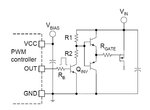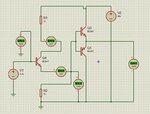giovaniluigi
Member level 1
I need to drive a load with PWM using a P-Channel MOSFET and I need to supply current enough to drive the gate at high frequency whithout having too much loss.
The circuit is as follows:

As faster as I can turn ON/OFF as less loss I'll have on the MOSFET.
The P Mosfet should be ON when the Vgs(th) > 2.5V but the Vgs(th) should not exceed 25V.
The problem is that the (VBAT) rail in the circuit above is 48V, when I pull the gate to GND it would destroy the MOSFET.
With the voltage divider and the zener diode I solve the problem, but the resistor also limits the current to the gate.
How can I drive the P MOSFET within the safe limits and also being able to provide let's say 200mA to the gate (if needed) ?
The circuit is as follows:

As faster as I can turn ON/OFF as less loss I'll have on the MOSFET.
The P Mosfet should be ON when the Vgs(th) > 2.5V but the Vgs(th) should not exceed 25V.
The problem is that the (VBAT) rail in the circuit above is 48V, when I pull the gate to GND it would destroy the MOSFET.
With the voltage divider and the zener diode I solve the problem, but the resistor also limits the current to the gate.
How can I drive the P MOSFET within the safe limits and also being able to provide let's say 200mA to the gate (if needed) ?


